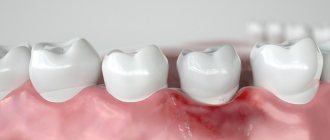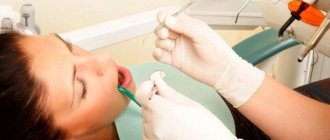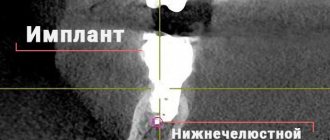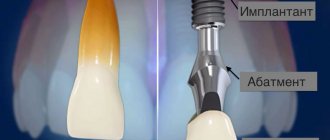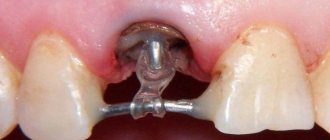What does pain depend on?
How long does the pain last? Localization of pain Pain during implantation Pain during prosthetics How to reduce pain? When to urgently consult a doctor? What to do if your jaw and gums hurt after dental implantation? Is this considered normal and how long can it last? Do I have to endure it? Let's look at it in more detail in our article.
During the implantation of a titanium rod into the bone, a puncture is made in the gums, and tissues and blood vessels are consequently injured, so pain, swelling or slight bleeding is a normal response of the body.
The implantation itself takes place without pain, since the procedure for installing an artificial tooth root is carried out under anesthesia. After its effect ends, sensitivity returns, an aching, throbbing pain syndrome appears, it should go away on the 10th day or earlier.
How to avoid complications after implantation
- How to behave after surgery
- Postoperative nutrition
- How long does it take to heal?
- How are sutures removed?
- Postoperative complications
- Swelling after dental implantation
- Inflammation and temperature
- Numbness
- Antibiotics after implantation
- Simultaneous (immediate) implantation
During implantation, the dentist places an artificial tooth root into the gum, which then becomes the basis for a removable or fixed denture. The operation is always complex and multi-stage, and to achieve success it requires the joint work of the doctor and the patient. Even at the current level of development of medicine, it is impossible to completely guarantee the absence of complications: aching pain, hematomas, swelling, bleeding, infection, fever. It is also possible for the implant to fail.
But if you follow the recommendations, it will be easier to avoid complications, and the implant will take root faster.
So, what to do after dental implantation to quickly relieve the consequences of surgery and the best healing of the gums?
How to behave after surgery
Doctors give the following recommendations after dental implantation:
- Do not use irrigators. Any treatment of the oral cavity should be as soft and gentle as possible. Oral baths are indicated. Active rinsing with antiseptic solutions is prohibited before the sutures are removed.
- Brush your teeth with gentle movements using a soft brush (your doctor will recommend a brush). You can use dental floss and superfloss. But it is better to clean your teeth directly at the operation site only with a cotton swab dipped in a 3% hydrogen peroxide solution.
- Avoid involuntary sneezing, coughing and blowing your nose, especially if the implantation is associated with sinus lift surgery. A sharp increase in pressure in the maxillary sinus can lead to mechanical damage to the bone tissue and displacement of the implant.
- Avoid extreme temperature changes. For this reason, it is better not to visit baths and saunas.
- Air travel can also be harmful because rapid changes in altitude make it difficult to avoid a surge in pressure in the ear-nose-throat system.
Side effects
It is necessary to stop taking Ketonal if the following side symptoms appear:
- nausea and vomiting;
- heart rhythm disturbances;
- diarrhea;
- severe headache;
- sleep disorders;
- allergic reactions on the skin;
- difficulty breathing;
- violations of the pronunciation of words and sounds;
- increased blood pressure.
In such cases, the doctor can adjust the dose of Ketonal or replace it with similar drugs with an analgesic effect.
Postoperative nutrition
Avoid hot foods until the anesthesia wears off. If you eat or drink something too hot, you can accidentally burn your gums because they won't feel the temperature.
In the first two days, do not drink coffee: it increases blood pressure and this can lead to bleeding. This also explains the requirement to exclude alcohol and smoking.
Within 10 days after surgery, to strengthen injured bone tissue, include calcium-containing foods in your diet: cottage cheese, kefir, yogurt.
Do not eat salty, spicy, very hot or frozen foods, as well as rough foods - crackers, nuts. The load on the teeth should be reduced as much as possible, so you should avoid foods that require careful active chewing - for example, tough meat.
The best option for a postoperative diet is pureed, semi-liquid, moderately warm food (soups, cereals, smoothies), or finely chopped.
How long does it take to heal?
Bone tissue and gums heal after dental implantation on average from three to six months, and the period is different for the upper and lower jaws. The lower jaw will heal in three to four months, but the upper jaw will take longer: four to six months. This is due to the greater bone density of the lower jaw.
Sometimes the healing rate deviates from the average time frame, because it depends on the individual characteristics of the patient’s body: the speed of regeneration, the strength of the immune system, the pain threshold. Even such factors as gender, age, lifestyle, diet and daily routine of the patient are important.
In any case, recovery after surgery takes some time. Following medical recommendations will help protect yourself from complications during healing.
Dosage and methods of application
You can buy Ketonal without a prescription, but long-term use without a doctor’s prescription is not recommended. The main danger of self-medication is that the drug does not treat pain. Dental pathologies progress without timely treatment and lead to serious complications, for example, infection of nearby areas (sinuses, upper respiratory tract, brain) and blood poisoning.
In order to minimize the likelihood of developing side effects from taking NSAIDs, you must follow some rules indicated in the annotation for the drug:
Antibiotic for tooth pain
- Take Ketonal in tablet form with plenty of water.
- Take a glass of milk if irritation of the gastrointestinal mucous membranes occurs after taking the pill.
- Do not administer Ketonal solution for injection yourself. It is advisable that the procedure be carried out by a medical professional.
- Use the drug in the form of a gel and ointment no more than 2 times a day. It must be applied to problem areas in a thin layer. This form of the drug is not used in the treatment of dental disorders.
In order to prevent the development of negative symptoms during treatment, you must adhere to the established dosages. The treatment regimen for NVSP is indicated in the instructions for use, but it can be adjusted by a doctor for each specific case. When using Ketonal on your own, you should not exceed the indicated dosages.
The instructions for use of Ketonal indicate that its maximum daily dosage cannot exceed 200 mg. Ketonal Duo capsules are drunk 1 piece per day, since the amount of active substance in them is 2 times more than in regular tablets. The drug in tablets begins to act 15-20 minutes after administration. The exact time of onset of the effect will depend on the characteristics of each person’s body.
Rapid pain relief can be achieved by using an injection solution. The result from using the solution is observed after 15 minutes
How are sutures removed?
Sutures after dental implantation are usually removed 10-14 days after surgery, unless otherwise indicated. Throughout this period, surgical sutures need careful, delicate handling. After suturing, there may be some discharge or slight pain. It is permissible to use painkillers (Nise, Ketanov or another remedy recommended by a doctor).
Modern dentistry uses strong synthetic threads that do not break even with active chewing of food, so dental sutures now rarely come apart. But suture dehiscence is still possible - however, it is most often associated with violations of medical recommendations, most often with mechanical damage to the operation area.
Removal of sutures does not require anesthesia and is completely painless.
Postoperative complications
The most common complications after dental implantation are:
- Pain syndrome. The norm is mild soreness of the gums in the area of implantation for 1-2 days. In cases where severe pain does not go away even after taking the generally recommended painkiller, you should consult a doctor, because this is most often a symptom of a complication.
- Inflammation.
- Seams coming apart.
- Hemorrhages. After surgery, ichor often separates from the gums, the amount of which quickly decreases and disappears. It is enough to remove it with cotton swabs. But if the bleeding becomes more intense, you should consult a doctor immediately.
There are also complications such as inflammation of the sinuses, peri-implantitis (inflammation of the tissue around the implant, leading to destruction of the supporting bone tissue), mucosal hyperplasia (pathological growth of the mucous membrane in the area of the implant), damage to the implant and prosthesis.
special instructions
People with chronic gastrointestinal diseases are recommended to drink NSAIDs together with antacid medications (Maalox, Phosphalugel). They do not affect the effectiveness of Ketonal, but protect the walls of the stomach and intestines from irritation.
Elderly people using the drug for toothache need to monitor their blood biochemical composition. The same rule applies to patients taking medication for a long time.
It is recommended that women planning pregnancy not take the medication. Non-steroidal drugs reduce the chance of successful implantation of a fertilized egg.
It is necessary to stop consuming Ketonal immediately if signs of individual intolerance to its components appear. A similar reaction is manifested by skin rashes and swelling of the respiratory system. If these signs appear, you should take an antihistamine and consult your doctor.
Ketonal is able to influence cells of the nervous system. With oral, rectal and parental administration of the drug, drowsiness and dizziness may occur. An adverse symptom also develops in cases where the medication was taken with strict dosage considerations. Because of this, Ketonal is not recommended for people working in hazardous industries and driving vehicles.
Swelling after dental implantation
In the first three days after implantation, swelling may occur in the gum tissue. This is the body's natural reaction to surgery. Most often, a tumor is an indicator that blood is actively flowing to the operation site.
But if you want to avoid the discomfort caused by swelling, you can reduce the risk of its occurrence. To do this, in the first two days, apply cold to the operation site: for 5-10 minutes with breaks of 20 minutes. Do not apply ice directly to the skin; it is best to wrap it in a towel. In rare cases, the tumor will require the use of antihistamines, antibiotics (to prevent infection) or treatment with antiseptic solutions.
It will also help to avoid swelling by eliminating sudden stress loads on the body: physical overload, hypothermia, overheating.
Therapeutic effect
Ketonal has a complex effect on the human body: antipyretic, anti-inflammatory, anesthetic. This property allows them to be used for pain of moderate to severe severity. The drug relieves discomfort in 10-15 minutes (depending on the form of release), and the effect of its consumption is observed for 6-8 hours.
Useful information: Ketonal Duo capsules have a prolonged action. The effect of their use is observed up to 11-12 hours.
The effect of introducing suppositories will be noticeable after 20-30 minutes. They act more slowly than Ketonal in tablets or injections, but the results from their use last as long as from the consumption of capsules
Ketonal belongs to the group of potent NSAIDs, so it can only be used if absolutely necessary. With minor discomfort, it is better to resort to drugs with a smaller list of side effects: Analgin, Paracetamol.
Inflammation and temperature after dental implantation
Your body may also react to surgery with a low-grade fever, that is, an increase in general body temperature to 37°C. Even if the temperature stays within these limits for several days, this will remain the norm. You should be wary only when there is a persistent increase in temperature to 37.8-38°C. In this case, it almost certainly means inflammation, which requires immediate intervention (for example, in case of peri-implantitis, this should be sanitation of abscesses, bone regeneration, as well as professional oral hygiene).
In this case, you should not delay visiting a doctor: the inflammation can not only worsen on its own, but also lead to implant rejection.
Ketonal in the practice of a rheumatologist
Z
Joint diseases are one of the most common reasons for a patient to visit a doctor (Fig. 1).
The pain syndrome accompanying damage to joints and periarticular tissues in most cases is chronic, significantly worsening the patient’s quality of life. Although there are many reasons for the appearance of pain in various structures of the musculoskeletal system: pain can be associated with damage to blood vessels or nerves, with increased intramedullary pressure, with spasm of the periarticular muscles, but most often the pain syndrome is associated with the development of chronic inflammation in the synovium
. Patients suffering from rheumatoid arthritis, ankylosing spondylitis, and psoriatic arthropathy are often forced to take painkillers for many years, which should also have an anti-inflammatory effect. The increasing incidence of deforming osteoarthritis in the population also increases the number of patients in need of pain-relieving agents. Therefore, certain requirements are imposed on drugs that reduce inflammation and pain: the drugs must be effective and well tolerated both in the short term and over long periods of use.
Rice.
1. The incidence of various diseases in the population (US National Health Interview Survey, 1999) Nonsteroidal anti-inflammatory drugs
(NSAIDs) have three main actions - analgesic, anti-inflammatory and antipyretic.
They are widely used in medical practice, primarily for the relief of acute and chronic pain of various origins. Most drugs in this group are, by their main mechanism of action, non-selective inhibitors of the enzyme cyclooxygenase (COX), which is involved in the breakdown of phospholipids in cell membranes when cells are damaged [1], which determines their therapeutic effect (suppression of COX-2), but is also associated with the development of adverse reactions (suppression of COX-1). These provisions formed the basis for the development of a new class of NSAIDs - COX-2 selective drugs
(meloxicam, nimesulide, celecoxib), the effectiveness of which in chronic inflammatory diseases of the musculoskeletal system is well known to clinicians, and the tolerability in relation to the mucous membrane of the gastrointestinal tract (GIT) is comparable using placebo [2,3]. When using non-selective COX inhibitors, it was believed that a more pronounced analgesic or anti-inflammatory effect is necessarily associated with a higher frequency of side effects. However, in recent years, new facts have emerged about the COX-independent mechanisms of the effectiveness and toxicity of NSAIDs [4]. There have been reports that non-selective NSAIDs have a central mechanism of analgesic action, which in most cases is more pronounced than that of selective COX-2 inhibitors [5,6].
The drug ketoprofen (Ketonal)
is a derivative of propionic acid, as well as the well-known and long-known ibuprofen and flurbiprofen.
Propionic acid derivatives are the most well tolerated among other non-selective NSAIDs. Its pronounced analgesic effect is well known, exceeding that of derivatives of phenylacetic acid (diclofenac) and indoleacetic acid (indomethacin). In this regard, “a priori” it was believed that ketoprofen should also be poorly tolerated. This may be why Ketonal is more widely used by specialists dealing with the problems of acute pain syndrome - surgeons, traumatologists, dentists, gynecologists and oncologists - than by specialists - rheumatologists. In the works of P.S. Veksheva et al. [7] optimal pain relief during minor traumatic surgical interventions in 94.3% of cases was achieved with Ketonal monotherapy at a dose of 100 mg 2–3 times a day. During highly traumatic surgical interventions, the use of Ketonal made it possible to reduce the dose of narcotic analgesics [8]. A comparative study of the effectiveness of various NSAIDs in postoperative pain relief showed the advantages of Ketonal (300 mg/day IM) over diclofenac (150–200 mg/day IM) and ketorolac (90 mg/day IM) with better tolerability of Ketonal: frequency adverse effects were 4%, 31% and 14%, respectively [9,10]. Also, high efficiency and better tolerability of Ketonal compared to indomethacin and diclofenac were noted in the treatment of pain in patients with malignant tumors [11]. When using Ketonal for pain relief in gynecological practice after endoscopic interventions, it was shown that the most effective form of the drug is forte tablets compared to suppository and capsulated forms
[12].
In most cases, a rheumatologist deals with chronic joint diseases (arthritis, arthrosis), when patients are forced to continuously use NSAIDs for many months and years. The required duration of taking NSAIDs and the known fact that the frequency of adverse reactions from the gastrointestinal tract (ulcers of the gastric and duodenal mucosa, bleeding) while taking NSAIDs is higher in patients with damage to the musculoskeletal system than in those suffering from other types of chronic pain [13 ], force the doctor to look for the safest drugs. However, selective COX-2 inhibitors in some forms of inflammation have an anti-inflammatory effect only in very high doses, when the synthesis of COX-1 is also suppressed.
Ketonal belongs to the group of propionic acid derivatives, which includes the safest NSAIDs, has a short half-life (T1/2 = 1–2 hours), rapid absorption and elimination [14]. Due to its high fat solubility, Ketonal quickly penetrates the blood-brain barrier and is able to influence the transmission of pain signals at the level of the dorsal horns of the spinal cord, which determines its central mechanism of analgesic action. These pharmacodynamic characteristics of ketoprofen served as the basis for the wider use of Ketonal in rheumatological practice. We conducted clinical and clinical endoscopic studies to study the effectiveness and tolerability of Ketonal in patients with severely active rheumatoid arthritis, ankylosing spondylitis with long-term use, as well as in patients with arthrosis. A number of special clinical studies have already shown that the pharmacokinetics of Ketonal in young and elderly people does not have pronounced differences [15,16]. In addition, ketoprofen does not have a significant effect on the synthesis of proteoglycans by chondrocytes in in vitro and in vivo studies [17], that is, it does not have a negative effect on articular cartilage.
According to our data, when prescribing various forms of Ketonal, the frequency of development of a positive effect was 87% when using the tablet form, 79% when using intramuscular injections and 100% when using Ketonal in the form of 5% cream. Interesting data from JS Walker et al. [18], who showed that in RA patients who “responded” to ketoprofen, before prescribing the drug, there was a significant increase in the concentration of tumor necrosis factor-a and a tendency to an increase in the level of other proinflammatory cytokines compared to patients who “did not respond” to ketoprofen. These data confirm that the pronounced anti-inflammatory and analgesic effects of ketoprofen are associated not only with COX-mediated inhibition of prostaglandin synthesis. The drug provides a rapid and reliable reduction in pain and parameters reflecting the level of inflammation in the joints.
In a clinical endoscopic study of the effectiveness and tolerability of Ketonal in various dosage forms in patients with active rheumatoid arthritis who received Ketonal in the form of suppositories (50 mg each), forte tablets (100 mg each) or retard tablets (150 mg each) for 3 -x months we received confirmation of the high analgesic and anti-inflammatory activity of Ketonal with its good tolerability [19]. The comparative frequency of erosive and ulcerative lesions of the gastrointestinal mucosa when using various NSAIDs is demonstrated in Figure 2. It can be seen that the frequency of damage to the gastrointestinal mucosa with the use of Ketonal is comparable to that with the use of selective COX-2 inhibitors.
Rice. 2. Frequency of damage to the gastrointestinal mucosa due to the use of NSAIDs
Thus,
Ketonal showed high effectiveness in the treatment of joint pain and inflammation in patients with chronic joint diseases in combination with good tolerability.
The drug can be successfully used for long-term treatment of such patients, including elderly patients.
References:
1. Vane JR Inhibition of prostaglandin synthesis as a mechanism of action for the aspiei-like drugs. Nature, 1971; 231; 235–239.
2. Nasonov E.L. Non-steroidal anti-inflammatory drugs (prospects for use in medicine). M., "Anko", 2000, 143 pp.
3. Crofford LJ, Lipsky PE, Brooks P. et.al., Basic biology and clinical application of specific cyclooxygenase–2 inhibitors. Arthr.Rheum., 2000; 43;4–13.
4. Fitzgarald GA, Partono C. The coxibs, selective inhibitors of cyclooxigenase-2. N.Engl.J.Med., 2001; 345;433–442.
5. Bannwarth B., Demotes–Mainard F., Schaeverbeke T. et.al. Central analgesic effects of aspirin–like drugs. Fund.Clin.Pharm., 1995; 9;1–7.
6. McCormack K., Urguhat E. Correlation between non-steroidal anti-inflammatory drug efficacy in a clinical pain model and the dissociation of their anti-inflammatory and analgesic properties in animal model. Clin. Drug Invest., 1995; 9; 88–97.
7. Vetshev P.S., Chilingaridi K.E., Ippolitov L.I. and others. Surgical stress in various types of cholecystectomy. Surgery, 2002, No. 3, pp. 4–10.
8. Vetshev P.S., Vetsheva M.S. Principles of analgesia in the early postoperative period. Surgery, 2002, No. 12, 49–52.
9. Kirienko P.A., Gelfand B.R., Levanovich D.A. etc. Comparative assessment of the effectiveness of non-steroidal anti-inflammatory drugs used for postoperative pain relief. Consillium medicum, Surgery No. 2, 2002.
10. Gelfand B.R., Kirienko P.A., Levanovich D.A., Borzenko A.G. Comparative assessment of the effectiveness of non-steroidal anti-inflammatory drugs used for postoperative pain relief. Bulletin of Intensive Care, 2002, No. 4, Postoperative period, pp. 83–88.
11. Novikov G.A., Vaisman M.A., Prokhorov B.M. et al. Ketonal in the treatment of pain in patients with common forms of malignant neoplasms. Palliative Medicine and Rehabilitation, No. 3, 2002, 48–51.
12. Ailamazyan E.K., Niauri D.A., Ziyatdinova G.M. Clinical and economic rationale for the use of ketonal for pain relief after endoscopic interventions in gynecology. Russian Bulletin of Obstetrician and Gynecologist, No. 6, 2002, 51–53.
13. Janssen M., Dijkmans B., van der Sluijs FA “Upper gastrointestinal complaints and complications in chronic rheumatic patients in comparison with other chronic diseases” Br.J.Rheum., 1992., Vol.31: 747–752.
14. Williams RL, Upton RA The clinical pharmacology of ketoprofen. J.Clin.Pharm., 1988; 28: 13–22.
15. Schattenkirchen M. Long-term safety of ketoprofen in an elderly population of arthritis patients. Scand.J.Rheum., 1991; 91(Suppl.): 27–36.
16. Le Loet X. Safety of ketoprofen in the elderly: a prospective study on 20,000 patients/ Scand.J.Rheum., 1989; 83:21–27.
17. Huber–Brunning O., Willbrinck B., Vanroy J., Vanderveen MJ Potential influences of ketoprofan on human healthy and osteoarthritic cartilage in vitro. Scand. J Rheum 1989;18:29–32.
18. Walker JS, Sheater–Rehd RB Carmody JJ et.al. Nonsteroidal anti–inflammatory drugs in rheumatoid arthritis and osteoarthritis. Support for the concept of “responder” and “nonresponder”. Arthr.Rheum., 1987; 11: 1944–1954.
19. Chichasova N.V., Imametdinova G.R., Karateev A.E. and others. Efficacy and safety of ketoprofen (ketonal) for rheumatoid arthritis (clinical and endoscopic study). Scientific and practical rheumatology, 2001; 1:47–52.
Numbness after dental implantation
For most patients, anesthesia wears off within four to five hours after implant placement. Then oral sensitivity should return. If numbness persists after this period, then you have cause for concern because it may indicate nerve damage. This is only possible when the operation was performed on the lower jaw, because there are no large nerves in the upper jaw.
Other symptoms of mandibular nerve injury are lack of facial skin sensitivity, excessive salivation, and difficulty speaking and eating. Timely diagnosis will help to establish the nature and extent of the damage and manage the treatment with medications rather than surgical methods.
Composition and release form
The main component in Ketonal is ketoprofen. It alleviates the severity of discomfort by suppressing the production of substances responsible for pain. Ketonal is sold in pharmacies in several pharmacological forms:
- in tablets and capsules;
- in the form of products for external use (gel, ointment);
- in the form of rectal suppositories;
- in the form of ampoules intended for injections.
The doctor will be able to select the appropriate form of release of the drug and its dosage after studying the characteristics of the patient’s problem and taking into account the intensity of his pain. When treating pathologies of the musculoskeletal system, it is recommended to use Ketonal in the form of ointments and gels. To eliminate neurological pain, an injection solution is used. Headaches, dental and menstrual pain are relieved with tablets.
The longest therapeutic effect is observed from the use of Ketonal suppositories. The fastest effect in relieving pain can be achieved by using the solution.
Ketonal Duo capsules have 2 colors: white and blue. The manufacturer did this in order to combine several therapeutic properties of the drug: long-lasting action and rapid pain relief.
The blue granules contain substances that allow the active component to influence the site of inflammation longer. White granules contain a larger amount of the active ingredient. Their main goal is to relieve unpleasant symptoms in a short time.
Antibiotics after dental implantation
For preventative purposes, the doctor prescribes a course of antibiotics after surgery. In most cases, this is inevitable, since surgical trauma, even with the modern level of development of medicine, carries a high risk of infection. Therefore, it is better not to ignore antibacterial drugs prescribed by a doctor if you do not want to additionally place unnecessary burden on your immune system to fight infection.
Most often, the course of antibacterial therapy does not exceed 7 days, and broad-spectrum drugs are prescribed - amoxicillin, amoxiclav, cephalosporins. They are characterized by low toxicity and have long proven themselves to be well tolerated by the human body.
Contraindications
Ketonal has a strong therapeutic effect. There are a number of contraindications to its use:
- digestive system dysfunction;
- serious pathologies of the liver and kidneys;
- problems with blood clotting;
- natural feeding;
- anemia;
- exacerbation of chronic gastrointestinal diseases;
- stomatitis in acute form;
- heart failure;
- diabetes.
Taking Ketonal is also not recommended for people dependent on alcohol. Taking medication and alcohol together can have serious consequences for the body.
Before consuming Ketonal and other medications together, you should consult your doctor. Some groups of medications are incompatible with NSAIDs.
Simultaneous (immediate) implantation
This prosthetic method is a one-stage implantation. In this case, the dentist removes the patient’s damaged tooth and immediately installs an artificial root.
Implantation immediately after tooth extraction is only possible if the bone tissue has sufficient volume to accommodate the implant - for example, if the tooth was damaged or lost in an accident. But tooth loss much more often occurs due to diseases when bone tissue is lost. Therefore, this method is not always available.
Dental implantation is an achievement of modern dentistry that allows you to restore lost teeth and use them for the rest of your life. And if you carefully follow your doctor’s recommendations, your smile will always bring joy to your loved ones!
Pain during implantation, is it painful to install an implant?
For those who were once familiar with the removal of eights (wisdom teeth), they know how unpleasant it is. Implantation is a completely painless operation. The anesthesia is enough to make everything comfortable. The patient feels manipulation in the oral cavity, but there is no pain. Even the injection itself with an anesthetic solution can be made invisible. After treating the puncture site with special means.
There are several types of anesthesia for implantation:
- local
, used in most cases.
It is quite enough for work. An injection is given and within a few minutes the medicine begins to act. Installation of one implant takes 15-30 minutes
, and the effect of anesthesia ends after a few hours; - sedation
_ The patient is half asleep, there are no unpleasant sensations, but there may be consequences; - anesthesia
_ To undergo implantation under anesthesia, you will need to undergo certain tests and consult an anesthesiologist. Coming out of anesthesia takes time. This method is used very rarely, it is not available in all clinics and can be dangerous.



